Disclaimer: This blog post contains affiliate links. If you make a purchase through these links, I may earn a small commission at no additional cost to you. Learn More. Thank you for supporting our garden community.
3 Cheap and Easy Bean Trellis Ideas for Growing Tons of Beans
Beans are one of the easiest and most rewarding crops to grow, but if you want to maximize your harvest and keep your plants healthy, using a bean trellis is essential. A proper trellis helps climbing beans grow upwards, saves space, improves airflow, and makes harvesting easier. In this guide, we’ll cover why you need a bean trellis, the 3 best types of trellises, and how to set one up for a thriving bean crop.
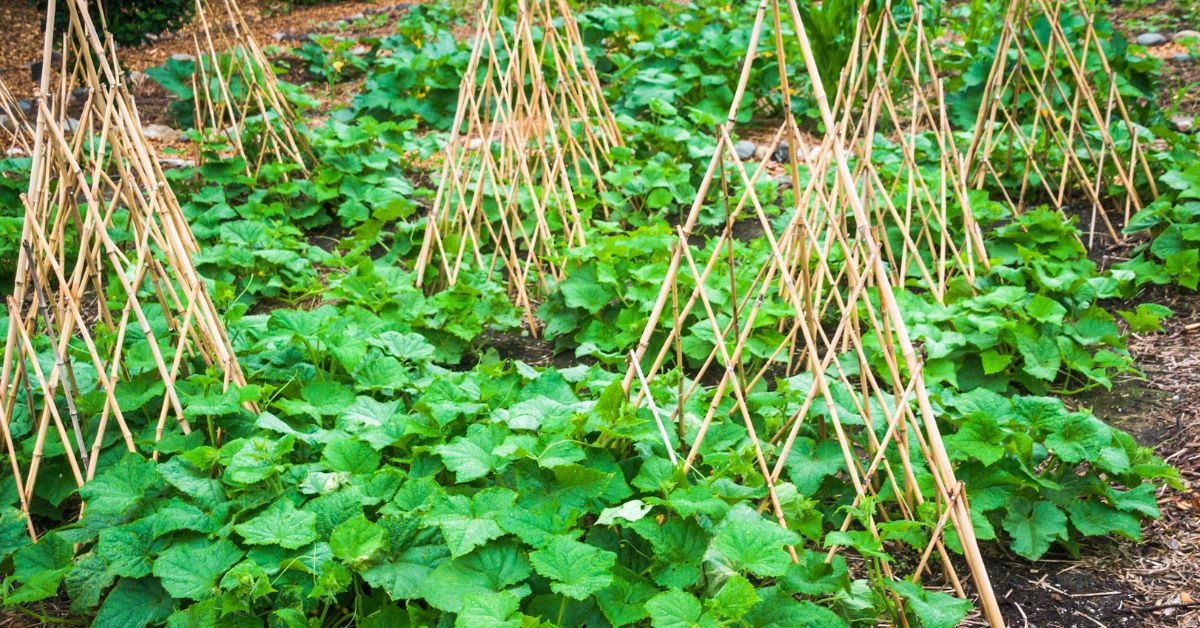
Cheap and Easy Bean Trellis Ideas
There are many types of bean trellises, each with their own different uses. Obviously they all provide support for bean plants, but some are better than others.
I’ve tried and tested a lot of trellises in the past, and let’s just say that there’s a reason why only 3 made it on this list.
A lot of them are just bad ideas, but not these ones. These are the best cheap and easy bean trellises that everyone should use in their garden.
That being said, let’s get right into the 3 cheap and easy bean trellis ideas for growing tons of beans.
Products:
Save 10% on your first Burpee seed order using code BURPEE10
Easy to Grow seed varieties from Burpee for guaranteed success
Natural biodegradable jute twine
Understanding Pole Beans
Pole beans, also known as climbing beans, are bean varieties that grow vertically like a vine.
They can grow to over 10 or 15 feet tall, so they’ll take up a lot of space if they’re grown horizontally. If you use a trellis, the whole plant can be grown vertically.
These varieties grow for a longer period of time in the growing season, often producing until the first frost. This also makes it so that there is a greater bean yield per plant.
But unlike true vines, pole beans don’t have tendrils that grab onto the trellis. If you’ve ever seen cucumbers or grapes growing, you know that they put out little tendrils that actually attach themselves to their trellis.
Instead, pole beans use their stem to wind up the trellis.
Understanding Bush Beans
Bush beans are different from pole beans in the sense that they don’t produce vines. You can tell from the name that they stay the size of a bush.
They usually only reach 2-3 feet tall. Because they naturally stay close to the ground, they actually don’t need a trellis to support them.
However, I’ve used a trellis for bush beans in the past and I think it only helps to keep some of the lower beans away from the dirt. But for the most part, you don’t need to use a trellis for bush beans.
Because of this, all of the trellises mentioned in this article will only be for pole beans.
Why Should You Use a Trellis for Beans?
Because pole beans grow so tall, they need to be trellised to support all of the leaves and fruits. So here’s a few reasons why you should trellis your beans:
- Increase Yield: If you allow the plants to grow vertically, they’ll produce more fruit, especially compared to bush beans.
- Saves Space: Growing beans vertically saves so much space in your garden. Instead of having the vines sprawl everywhere and take up all the soil space, you can trellis them upwards. This gives you more soil space to plant other crops.
- Prevents Disease: By keeping your bean plants off the ground, you improve airflow and circulation around them. This reduces the risk of fungal diseases, like powdery mildew.
- Prevents Pests: Pests like slugs and rodents generally won’t be able to reach your plants if they’re growing vertically. They usually attack plants that are closer to the ground.
- Easier Harvesting: Beans growing on a trellis are at eye level, making it so that you can actually see the ripe beans when they’re ready. Additionally, you won’t have to bend down to the ground and break your back searching for beans.
How Tall Should a Bean Trellis Be?
Considering that pole beans can grow to over 15 feet, there’s no way your trellis can be that tall.
A good modest size would be about 7-8 feet tall. So if you use 8 foot stakes and hammer them into the ground about 1 foot, then your trellis will be 7 feet tall.
If the plants get any larger, then they’ll just hang down and continue growing.
1. Pole and String Trellis
This is the simplest bean trellis and it’s great if you have a lot of plants in a row.
It’s also good to use with lots of containers or 5 gallon buckets in a row. Just make sure that your row is straight and levelled off nicely.
Here’s how to set it up:
- Get a few 8 foot stakes, either wood, metal, or bamboo. I like using T-posts because the string can easily rest on those little nubs.
- Hammer the stakes into the ground about 1 foot deep and 3 feet apart. This will make the trellis about 7 feet tall.
- Tie twine between all the posts, running horizontally every 2-3 inches. Or, you can use netting if you want.
- As the beans grow, make sure they attach themselves to the trellis.
- Continue to tie and
Like I said, this bean trellising method is great for large plantings of beans. And it’s cheap and easy to make yourself.
On the other hand, some of the cons are that it requires regular tying and training to allow the beans to grow properly, and it may be weak in strong winds or a big storm.
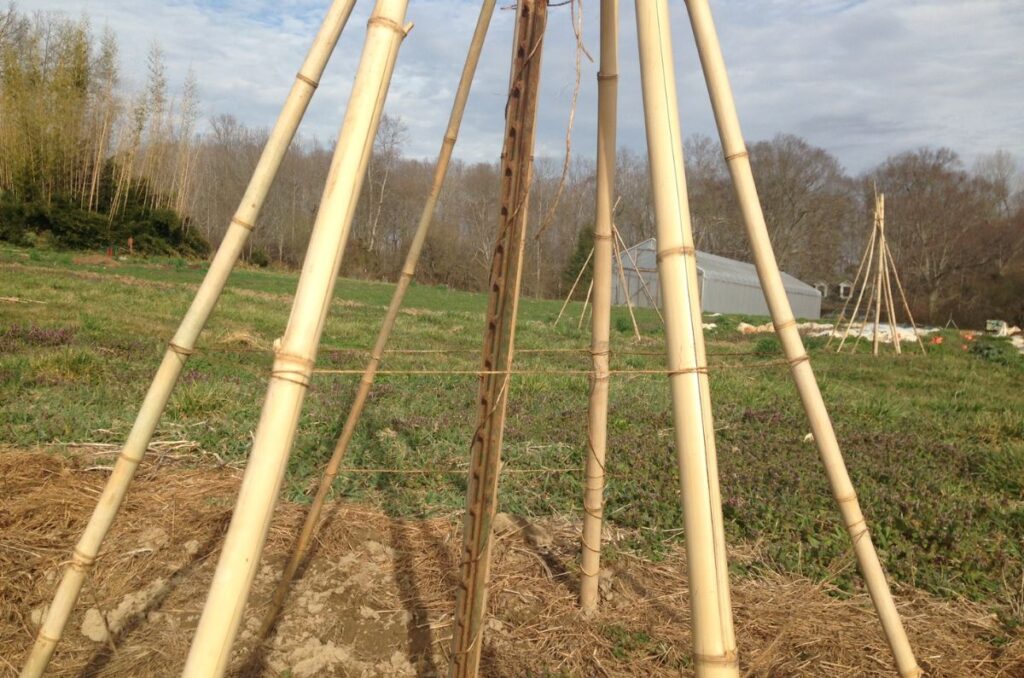
2. Tipi Trellis
This trellis is named after the collapsible structure used by North American native tribes. It’s meant to resemble this structure, allowing the beans to grow upwards in a circle.
Here’s how to set it up:
- Use six 8 foot bamboo poles or wooden poles.
- Put them in a bundle, wrap twine around them several times, and tie it together tightly. Leave a little bit of slack to allow you to spread them out once tied.
- Then wrap twine around the original twine, going in between the bundle of poles. Tie this tightly as well.
- Spread them apart and push the poles into your soil equidistant from each other.
- Plant 2 bean plants at the base of each pole. They should attach themselves pretty easily to the trellis.
The main benefits of using this trellis is that it’s attractive and is a fairly strong support trellis. It is aesthetically pleasing in the garden, so if that’s a concern, then use this trellis.
One of the problems I have with this is that it’s not really meant for large bean plantings. It can only grow beans in a small circle, not a full row like the last trellis.
Additionally, it might be hard to harvest the beans that are dangling in the middle of the tipi, but I guess that’s just part of it.
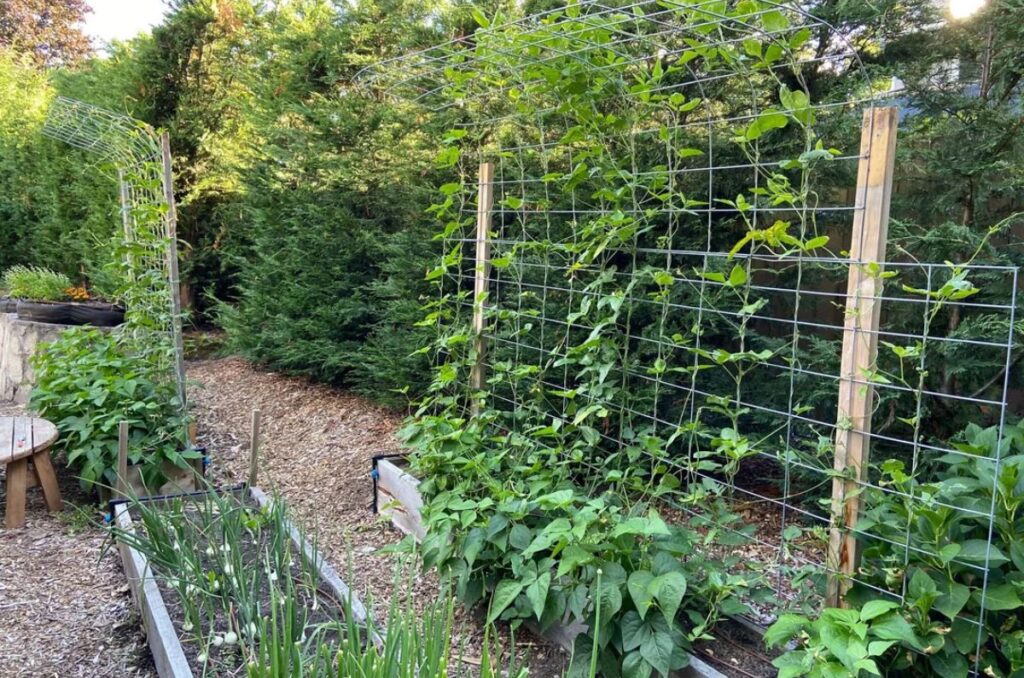
3. Cattle Panel Trellis
This is by far the best bean trellis on this list.
It’s best for large plantings, heavy-producing bean varieties, and long-term use. So if you’re growing a variety that you know will produce a ton, then this is the trellis for you.
But also if you want a trellis that you can reuse year after year, then this is also for you.
Here’s how to set it up:
- On your row of beans, hammer an 8 foot wooden stake every 4-5 feet.
- Get a strong and durable cattle panel and secure it onto every stake along the row. I like using wood stakes because you can just nail, screw, or staple the cattle panel right into them. If you’re using metal stakes, then you can just tie the cattle panel securely.
- Plant beans at the base of the trellis, and they should grow up fairly easily. There are lots of holes and things to grab onto, so they shouldn’t have a problem
If you’re worried about spending too much money on the cattle panel, then you can replace it with netting. The only problem with netting is that it’s not nearly as strong.
Additionally, this trellis is definitely going to last you many years, so it’s a great investment.
How to Trellis Bean Plants
Typically, bean plants will naturally attach themselves to your trellis. But can’t always figure it out without your helps, so you need to manually train them for a bit before they can do it.
When you notice that the beans are starting to produce more vertical stems, then you can gently wrap them around the trellis.
If they don’t want to attach, then you can tie them to get started, and then they’ll eventually grow themselves.
Additionally, some parts on your trellis may remain empty if you don’t manually try to fill it in. Since beans produce many side shoots that develop into main stems, these can be redirected to grow in the bare spots.
Choosing the Best Bean Trellis for Your Garden
If you’re still a bit confused on which one to choose, consider these points:
- For small spaces: The tipi trellis is your best option. It’s pretty small itself and can fit almost anywhere.
- For heavy production: The cattle panel trellis easily takes this spot. It’s durable and long-lasting, providing support for heavy bean plants and fruit.
- For flexibility: The pole and string or modified cattle panel trellis with netting are the best options. These ones can be changed based on the size or shape of your garden.
Frequently Asked Questions
Yes, but since raised beds are slightly elevated, you might have to use a shorter trellis just so you can reach the beans. A trellis that’s about 5-6 feet should be fine for raised beds.
Yes, bean trellises can be used to grow cucumbers as well. Cucumbers grow similarly to beans, producing long vines that attach to a support structure.
Wood fences don’t have any place for the beans to latch onto, so you’ll have to create a few supports to get them started. Chain link fences, however, do allow for beans to attach themselves, so those would be perfect for growing beans.
Even More Gardening Ideas
Here are a few more posts to get the ball rolling in your garden!
- How to Grow Cucumbers from Seed to Harvest
- 5 Easy Tomato Trellis Ideas for ANY Garden
- Is Window Light Enough for Seedlings?
If you liked this article, make sure to share it with your friends and family members who are also looking to sharpen their gardening skills. Also, consider signing up for our email newsletter; don’t worry, we won’t send you spam, just fresh gardening ideas every week!
If you want to learn more about vegetable gardening, make sure to check out what I’m doing on Facebook, YouTube, and Pinterest.
Pin this post for later:
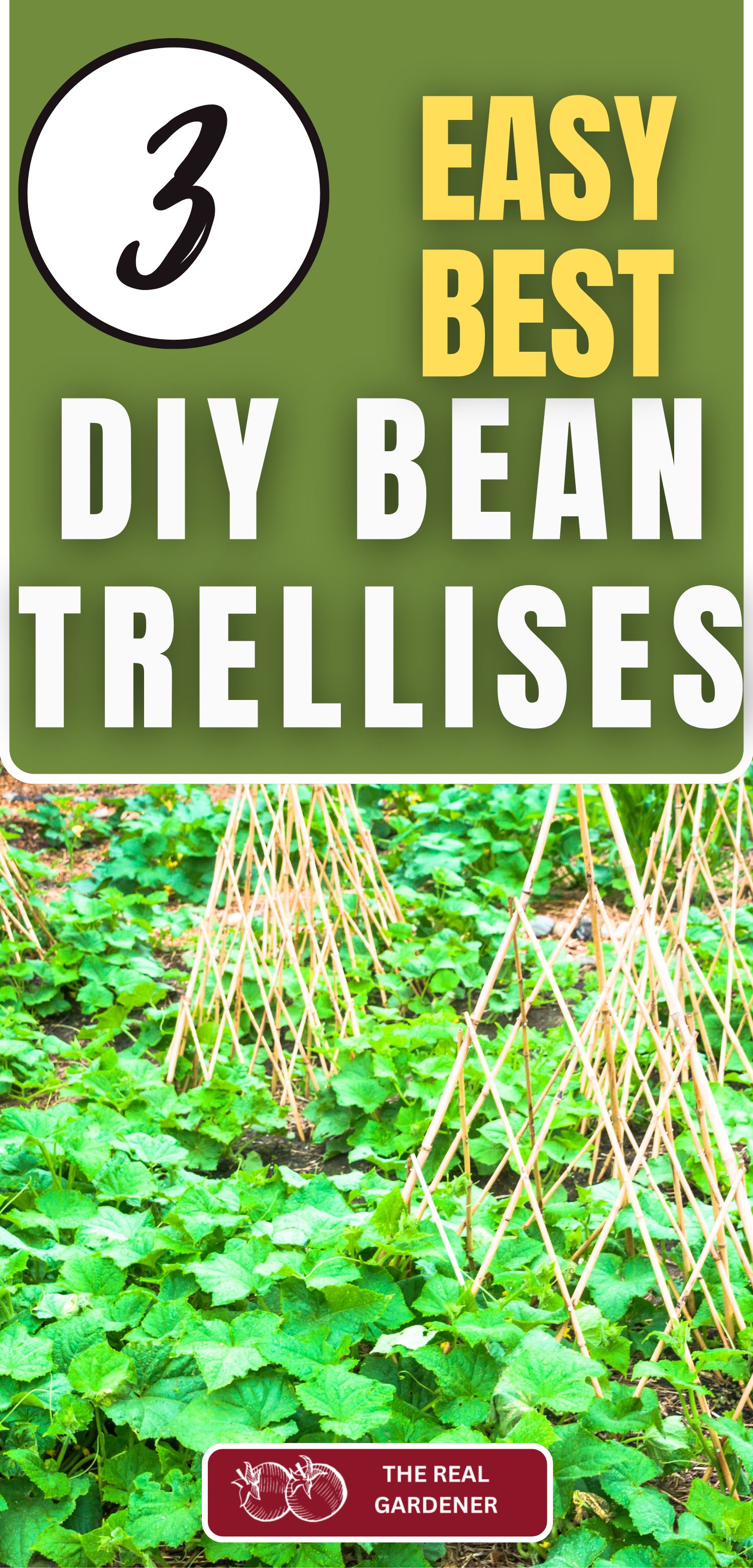
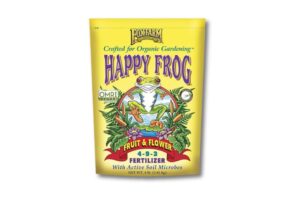
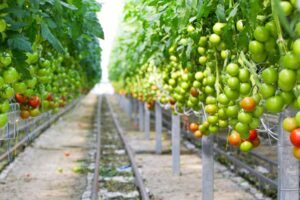
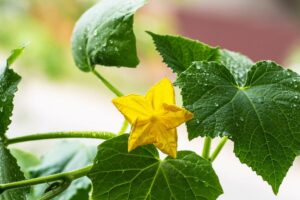


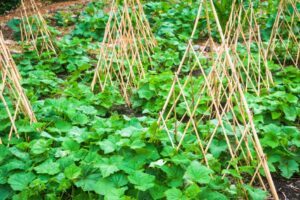
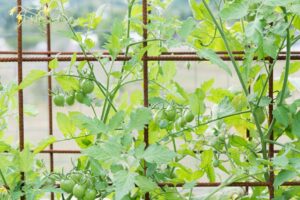
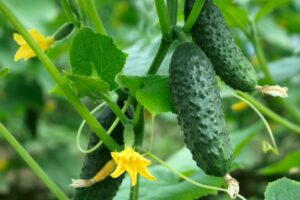
Leave a Reply